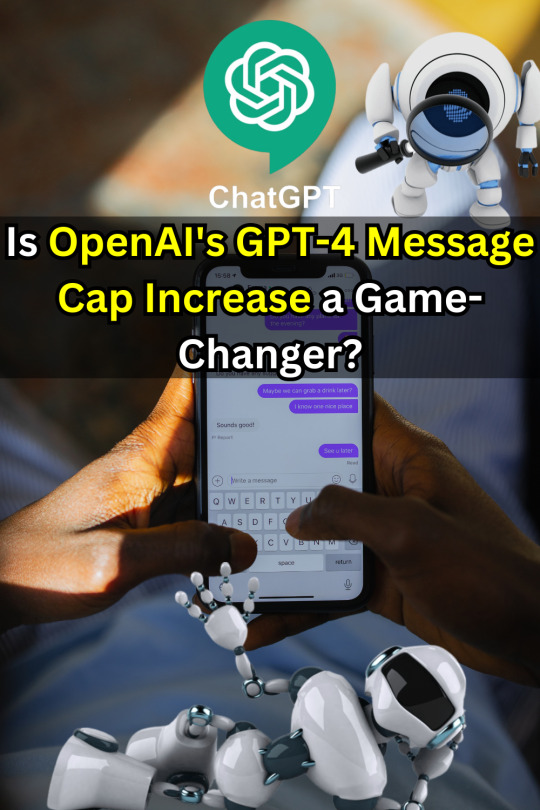#CodeInterpreter
Explore tagged Tumblr posts
Text
Remote MCP server, Code Interpreter, Image Generation in API

OpenAI Responses API
Developers and organisations can now use the Responses API with Code Interpreter, image generation, and remote MCP server functionality.
Today, OpenAI's Responses API, which creates agentic apps, gets more features. Image creation, Code Interpreter, and better file search are included, along with support for all remote Model Context Protocol (Remote MCP) servers. These tools support OpenAI o-series reasoning models, GPT 4.1, and GPT 4o.
The Responses API lets o3 and o4-mini call tools and functions directly in their chain of thought, producing more relevant and contextual responses. By retaining reasoning tokens across requests and tool calls, o3 and o4-mini with the Responses API improve model intelligence and reduce developer costs and latency.
The Responses API, essential for agentic systems, has been improved. Over hundreds of thousands of developers have used the API to handle billions of tokens for agentic applications like education aids, market intelligence agents, and coding agents since March 2025.
New features and built-in tools improve agentic systems constructed with the Responses API's functionality and dependability.
Additional Responses API Resources
Many new tools are incorporated into the Responses API:
Remote MCP Server Support
Remote Model Context Protocol (remote MCP) servers can now connect to API tools. Open protocol MCP standardises how apps give Large Language Models (LLMs) context. MCP servers let developers to connect OpenAI models to Cloudflare, HubSpot, Intercom, PayPal, Plaid, Shopify, Stripe, Square, Twilio, and Zapier with little code. OpenAI joins the MCP steering committee to improve the ecosystem and standard.
Image making
Developers can use OpenAI's latest image generating model, gpt-image-1, in the Responses API. This program supports multi-turn edits for granular, step-by-step image editing through prompts and real-time streaming for image previews. Even if the Images API can produce images, the Responses API's image generating tool is innovative. The reasoning model series o3 model supports this tool.
Interpreter Code
Responses API now has this utility. The Code Interpreter can aid with data analysis, complex mathematics and coding challenges, and “thinking with images” by empowering models to understand and deal with images. Models like o3 and o4-mini fare better on Humanity's Last Exam when they use the Code Interpreter.
Enhancements to File Search
Since March 2025, the API has offered file search, but new functionalities have been introduced. Developers can use the file search tool to extract relevant document chunks into the model based on user queries. The changes enable vector storage searches and attribute filtering with arrays.
These tools work with the GPT-4o, GPT-4.1, and OpenAI o-series reasoning models (o1, o3, o3-mini, and o4-mini for availability under the pricing/availability section). Developers can use these built-in technologies to construct stronger agents with one API call. Industry-standard benchmarks show that models that call more tools while reasoning perform better. O3 and o4-mini's ability to invoke tools and functions straight from their reasoning yields more contextually relevant responses.
Saving reasoning tokens across tool calls and requests improves model intelligence and reduces latency and cost.
New Responses API Features
Along with the new tools, developers and enterprises may now use privacy, visibility, and dependability features:
Background Mode: This lets developers manage long tasks reliably and asynchronously. Background mode prevents timeouts and network issues while solving difficult problems with reasoning models, which can take minutes. Developers can stream events or poll background objects for completion to see the latest state. Agentic products like Operator, Codex, and deep research have similar functions.
Reasoning Summaries: The API may now summarise the model's internal logic in natural language. Similar to ChatGPT, this helps developers debug, audit, and improve end-user experiences. Reasoning summaries are free.
Customers who qualify for Zero Data Retention (ZDR) can reuse encrypted reasoning items between API queries. OpenAI does not store these reasoning pieces. Sharing reasoning items between function calls improves intelligence, reduces token usage, and increases cache hit rates for models like o3 and o4-mini, reducing latency and costs.
Price, availability
These new features and tools are available now. The OpenAI o-series reasoning models (o1, o3, o3-mini, and o4-mini) and GPT-4o and GPT-4.1 series support them. Only the reasoning series' o3 model supports image production.
Current tools cost the same. The new tools' pricing is specified:
Images cost $5.00/1M for text input tokens, $10.00/1M for image input tokens, and $40.00/1M for image output tokens with a 75% discount on cached input tokens.
Each Code Interpreter container costs $0.03.
File search costs $2.50/1k tool calls and $0.10/GB vector storage daily.
Developers pay for API output tokens, not the tool itself.
#remoteMCP#OpenAIResponsesAPI#OpenAI#ResponsesAPI#remoteModelContextProtocol#CodeInterpreter#technology#technews#technologyynews#news#govindhtech
0 notes
Text
بعض الأشياء المُثيرة التي يُمكنك القيام بها باستخدام Code Interpreter في ChatGPT

مع تطور تكنولوجيا الذكاء الاصطناعي ، تجتاح الابتكارات الجديدة عالم تطوير البرمجيات ، ومن بين هذه الابتكارات تبرز Code Interpreter في ChatGPT كأداة مبهرة. على الرغم من أنَّ الكثيرين لا يُدركون ذلك ، إلا أنَّ هذه الإضافة لها العديد من الاستخدامات المُثيرة ويُمكنها القيام بأكثر من مُجرد عدد قليل من المهام التي تُستخدم حاليًا من أجلها. إذن ، ما الذي يُمكنك فعله بالضبط باستخدام إضافة Code Interpreter الخاصة بـ ChatGPT؟ لقد جمعنا بعضًا من أكثر الطرق المُفيدة التي يُمكنك من خلالها استخدامها في الوقت الحالي وكيفية استثمار قدراتها لتحقيق نتائج مُذهلة. سنُقدم أيضًا نصائح عملية حول كيفية تحسين تجربتك مع Code Interpreter ، وكيفية تجنب الأخطاء الشائعة وتحقيق أفضل أداء. ستكتسب فهمًا أعمق لكيفية استخدام هذه الإضافة في مشاريعك البرمجية وكيفية الاستفادة منها لتسهيل عملية تطوير البرمجيات. تحقق من أفضل إضافات ChatGPT التي يُمكنك تجربتها الآن. Read the full article
0 notes
Text

#OpenAI#GPT4#ChatGPT#AIInteraction#MessageCap#CodeInterpreter#ChatGPTPlus#AIInnovation#TechAdvancements#ArtificialIntelligence#Chatbot#CapCut#DigitalTransformation#BusinessIntelligence#AIDevelopment#UserExperience#MachineLearning#AIChat#ConversationalAI#TechNews#AIApplications#AIforBusiness#AIExperimentation#ContentGeneration#TechnologyUpdates
0 notes
Text
How we can use Code interpreter to enhance reporting | financial report | management report
youtube
Enhancing financial and management reports using a code interpreter is a game-changer! In this short video, we'll dive into the exciting world of data analysis and visualization. Discover how to leverage code interpreters to automate report generation, analyze data dynamically, and create stunning visuals that make your reports more insightful and impactful. Stay tuned to revolutionize your reporting game!
#DataAnalysis#ReportAutomation#CodeInterpreter#FinancialReports#ManagementReports#DataVisualization#Efficiency#Insights#AutomationTools#BusinessIntelligence#Youtube
0 notes
Text
How we can use Code interpreter to enhance reporting | financial report | management report
youtube
Video Description: "Revolutionizing Reporting: Harnessing the Power of Code Interpreters for Financial & Management Reports 📈💻 Explore how code interpreters can supercharge your reporting, making it more dynamic, insightful, and efficient! #CodeInterpreters #FinancialReporting #ManagementReporting #DataVisualization #ReportAutomation #Efficiency #DataAnalysis #BusinessInsights #InnovationInFinance #TechInManagement #DataDrivenDecisions"
0 notes
Text
Code Interpreter And GTI For Gemini Malware Analysis

Using Google Threat Intelligence and Code Interpreter to Empower Gemini for Malware Analysis
What is Code Interpreter?
A tool that converts human-readable code into commands that a computer can understand and carry out is called a code interpreter.
What is code obfuscation?
A method called “code obfuscation” makes it more difficult to understand or reverse engineer source code. It is frequently used to hide data in software programs and safeguard intellectual property.
Giving security experts up-to-date tools to help them fend off the newest attacks is one of Google Cloud‘s main goals. Moving toward a more autonomous, adaptive approach to threat intelligence automation is one aspect of that aim.
As part of its most recent developments in malware research, it is giving Gemini new tools to tackle obfuscation strategies and get real-time information on indicators of compromise (IOCs). While Google Threat Intelligence (GTI) function calling allows Gemini to query GTI for more context on URLs, IPs, and domains found within malware samples, the Code Interpreter extension allows Gemini to dynamically create and run code to help obfuscate specific strings or code sections. By improving its capacity to decipher obfuscated parts and obtain contextual information depending on the particulars of each sample, these tools represent a step toward making Gemini a more versatile malware analysis tool.
Building on this, Google previously examined important preprocessing procedures using Gemini 1.5 Pro, which allowed us to analyze large portions of decompiled code in a single pass by utilizing its large 2-million-token input window. To address specific obfuscation strategies, it included automatic binary unpacking using Mandiant Backscatter before the decompilation phase in Gemini 1.5 Flash, which significantly improved scalability. However, as any experienced malware researcher is aware, once the code is made public, the real difficulty frequently starts. Obfuscation techniques are commonly used by malware developers to hide important IOCs and underlying logic. Additionally, malware may download more dangerous code, which makes it difficult to completely comprehend how a particular sample behaves.
Obfuscation techniques and additional payloads pose special issues for large language models (LLMs). Without specific decoding techniques, LLMs frequently “hallucinate” when working with obfuscated strings like URLs, IPs, domains, or file names. Furthermore, LLMs are unable to access URLs that host extra payloads, for instance, which frequently leads to speculative conclusions regarding the behavior of the sample.
Code Interpreter and GTI function calling tools offer focused ways to assist with these difficulties. With the help of Code Interpreter, Gemini may independently write and run bespoke scripts as necessary. It can use its own discretion to decode obfuscated elements in a sample, including strings encoded using XOR-based methods. This feature improves Gemini’s capacity to uncover hidden logic without the need for human participation and reduces interpretation errors.
By obtaining contextualized data from Google Threat Intelligence on dubious external resources like URLs, IP addresses, or domains, GTI function calling broadens Gemini’s scope while offering validated insights free from conjecture. When combined, these tools enable Gemini to better manage externally hosted or obfuscated data, moving it closer to its objective of operating as an independent malware analysis agent.
Here’s a real-world example to show how these improvements expand Gemini’s potential. Here, we are examining a PowerShell script that hosts a second-stage payload via an obfuscated URL. Some of the most sophisticated publicly accessible LLM models, which include code generation and execution in their reasoning process, have already been used to analyze this specific sample. Each model “hallucinated,” producing whole fake URLs rather than correctly displaying the correct one, in spite of these capabilities.Image credit to Google Cloud
Gemini discovered that the script hides the download URL using an RC4-like XOR-based obfuscation method. Gemini recognizes this pattern and uses the Code Interpreter sandbox to automatically create and run a Python deobfuscation script, successfully exposing the external resource.
After obtaining the URL, Gemini queries Google Threat Intelligence for more context using GTI function calling. According to this study, the URL is associated with UNC5687, a threat cluster that is well-known for deploying a remote access tool in phishing attacks that pose as the Ukrainian Security Service.
As demonstrated, the incorporation of these tools has improved Gemini’s capacity to operate as a malware analyst that can modify its methodology to tackle obfuscation and obtain crucial information about IOCs. Gemini is better able to handle complex samples by integrating the Code Interpreter and GTI function calling, which allow it to contextualize external references and comprehend hidden aspects on its own.
Even while these are important developments, there are still a lot of obstacles to overcome, particularly in light of the wide variety of malware and threat situations. Google Cloud is dedicated to making consistent progress, and the next upgrades will further expand Gemini’s capabilities, bringing us one step closer to a threat intelligence automation strategy that is more independent and flexible.
Read more on govindhtech.com
#CodeInterpreter#GeminiMalwareAnalysis#GoogleThreatIntelligence#GoogleCloud#phishing#Gemini15Pro#Gemini15Flash#malwareanalysis#technology#technews#news#govindhtech
0 notes